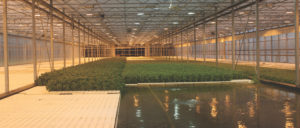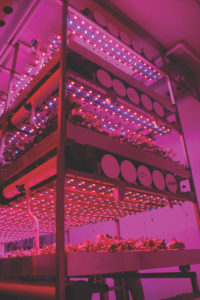Lighting Considerations for Controlled Environment Agriculture
There are several reasons why controlled environment agriculture is increasing in popularity. Undoubtedly, advances in lighting technology have been one of the factors contributing to this industry’s popularity and success.
Whether it is to increase growth and yield, control flowering, change forms, or alter flavor and appearances, horticultural lighting can be used to achieve these goals across controlled environments, from greenhouses to warehouses.

PHOTOSYNTHETIC LIGHTING
“A 1 percent increase in light is a 1 percent increase in yield.” That saying is one of the most important considerations to keep in mind when managing light for food crop production in controlled environments, and it highlights a fundamental difference between edible and ornamental crops.
Floriculture crops are sold as units: a flat of bedding plants, a poinsettia in a 6-inch container, or a bunch of cut flowers. Alternatively, food crops are sold based on weight: .-ounce of culinary herbs, a 12-ounce head of lettuce, or tomatoes sold by the pound. Photosynthetic light is one of the most influential factors that affect the mass or weight of fruits and vegetative growth.
Photosynthetically active radiation, light between 400 and 700 nanometers, can be measured instantaneously or cumulatively. Measuring light instantaneously, expressed as μmol∙m–2∙s–1, is most useful for static light sources such sole-source lighting in warehouse or shipping container production environments or supplemental lighting inside a greenhouse.
Light can also be measured cumulatively, expressed as mol∙m–2∙d–1, and is most useful for light sources that vary throughout the day — sunlight. Regardless how photosynthetic light is quantified, it important that sufficient light is provided to your crops to achieve quality growth and good yields.
The light requirements of food crops vary. However, most food crops are moderate- or high-light plants, requiring a minimum of 12 mol∙m–2∙d–1 for acceptable growth and more than 15 to 20 mol∙m–2∙d–1 for optimal growth.
There are a variety of technologies that can be used to provide photosynthetic light to plants grown in controlled environments, whether as sole-source or supplemental lighting. The two most popular technologies used for photosynthetic lighting are high-pressure sodium (HPS) lamps and light-emitting diodes (LEDs), and each has their own distinct advantages. For HPS lamps, the area covered or lit by each individual lamp is fairly large, which reduces the number of fixtures which need to be purchased, installed and operated (Figure 1).
Additionally, improvements in HPS lamps have been made so the now double-ended ballasts have efficiencies comparable to LEDs.
On the other hand, LEDs allow for narrow-spectrum lighting and the opportunity to provide specific wavelengths at specific proportions. The lack of radiant heat from LEDs also allows them to be placed close to plants without scorching them, whether as inter-canopy lighting in vine crops or for vertical farming applications (Figure 2). There is no one-size-fits-all answer to which lights are best; you’ll need to carefully examine your objectives and determine which lights best meet them.
PHOTOPERIODIC LIGHTING
Managing the photoperiod or day length can improve the production and productivity of plants with photoperiodic flowering responses. Whether flowering should be promoted or inhibited depends on what the crops are produced for.
Promoting flowering is most useful for those food crops which are grown for their flowers or fruits. For example, several edible flowers have a photoperiodic flowering response, including marigolds (a short day plant) and pansies (a long day plant). Strawberries need to have their flowering promoted because it is the prerequisite of fruit production. Cultivars have different photoperiodic flowering responses, with June-, summer- and ever-bearing cultivars flowering in response to short days long days, or either, respectively.
In contrast to flowering and fruiting food crops, flowering should be inhibited for those crops sold for their foliage to improve productivity. Take, for example, culinary herbs grown for their foliage; dill flowers in response to long days, while stevia flower in response to short days. By inhibiting flowering of these species, we can maximize foliage production.
Controlling the day length in indoor production facilities where there is no ambient sunlight is easy. To control the photoperiod in facilities where 100 percent of the light is electric, simply set the hours of operation for lights to the length of day you want, short or long.
In comparison to indoor production facilities, managing the photoperiod in the greenhouse is a bit more challenging. The only way to create short days when the natural days are long is by pulling blackout cloth over the crop to exclude sunlight. When the days are naturally short, long days can be created by extending the day length (day-extension lighting) or by interrupting the long nights (night-interruption lighting). Lighting for long days, whether day-extension or night-interruption, can be achieved with low intensity (2 μmol∙m–2∙s–1 minimum) or by operating photosynthetic lights during the dark hours.
PHOTOMORPHOGENIC LIGHTING
In addition to promoting growth or controlling flowering, light can influence the form or structure of plants; this is called photomorphogenesis. Photomorphogenic lighting in CEA is most commonly used when propagating transplants; specifically, promoting or inhibiting stem elongation of vine crop transplants.

One of the factors that affect stem elongation is light quality. More specifically, red light inhibits elongation, while far-red light promotes it, and these two wavelengths can be used to influence transplant growth.
Take, for example, grafted tomato plants. When grafting the rootstock and scion (or shoot) of young seedlings together, they can be difficult to handle due to the small size. Specifically, seedlings used as rootstocks are cut below the cotyledons so there is no chance their adventitious buds can develop into a fruiting shoot. It is easier to handle and work with rootstocks when the stem is slightly elongated. By providing far-red light to rootstock seedlings, stem elongation is promoted and results in rootstocks that are easier to handle during grafting.
Alternatively, stem elongation for vigorous-growing vining crops like cucumber or non-grafted tomato cultivars may need to be suppressed to avoid excessive stem length early in production. Supplementing ambient sunlight with red light can help suppress unwanted stem elongation. Blue light can also inhibit stem elongation, but if too much is provided it may also suppress leaf expansion more than desired, and should be used sparingly enough to provide some height control without other unwanted or unintended growth inhibition.
VALUE-ADDED LIGHTING
There are other applications where light can add value for our crops, either by improving their appearance or enhancing some other aspect that is appealing to consumers and ultimately improve sell-through or perceived value of crops, and this can be referred to as “value-added lighting.”
For leafy greens and herbs with purple foliage, including red leaf lettuce and opal basil, the foliage color can impact the marketability of the crop. During the winter when ambient light is low or indoors when electric light intensities are too low, the production of anthocyanin responsible for the purple coloration is diminished and produces less-than-purple or red foliage.
Although increasing the light intensity can improve coloration, a simpler approach can be to use blue light. When blue light is applied to these crops, anthocyanin development is enhanced. Blue light is a high energy wavelength and anthocyanin is developed so this high-energy light doesn’t negatively impact chlorophyll, acting like a “sunblock” to protect plants.
Adding blue light can also affect the production of phytonutrients. In culinary herbs, blue light has can enhance concentrations of compounds affecting aroma and flavor, while in lettuce it can enhance other beneficial antioxidant concentrations. By altering the aroma, flavor, or health benefits of food crops, you have the opportunity to differentiate the products you sell.
TAKE-HOME MESSAGES
The advances made in horticultural lighting technology, including the improvements in efficiency of HPS lamps or the development of LED lights, are one of the factors contributing to the popularity and success of CEA. The technology coming out is allowing us to produce crops more efficiently and effectively in traditional greenhouse environments, while also providing opportunities in new systems and environments, such as vertical farms or indoor facilities like shipping containers and warehouses.


 Video Library
Video Library 




















